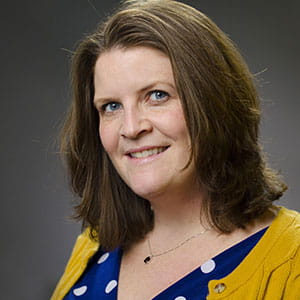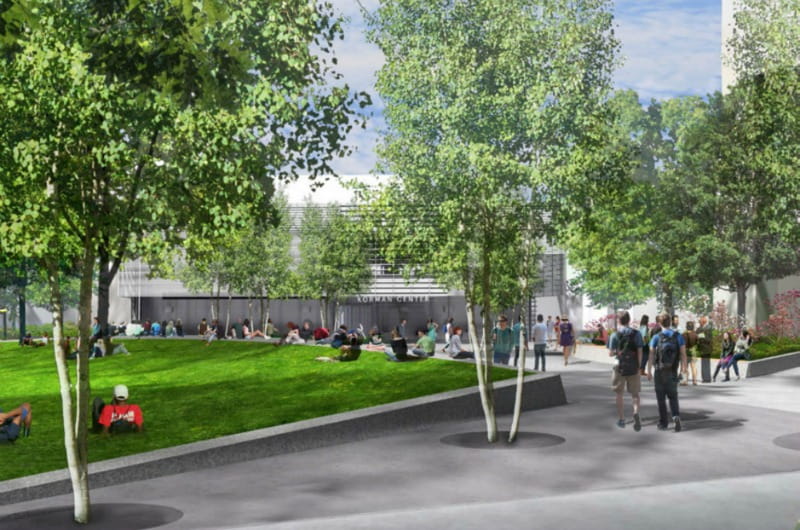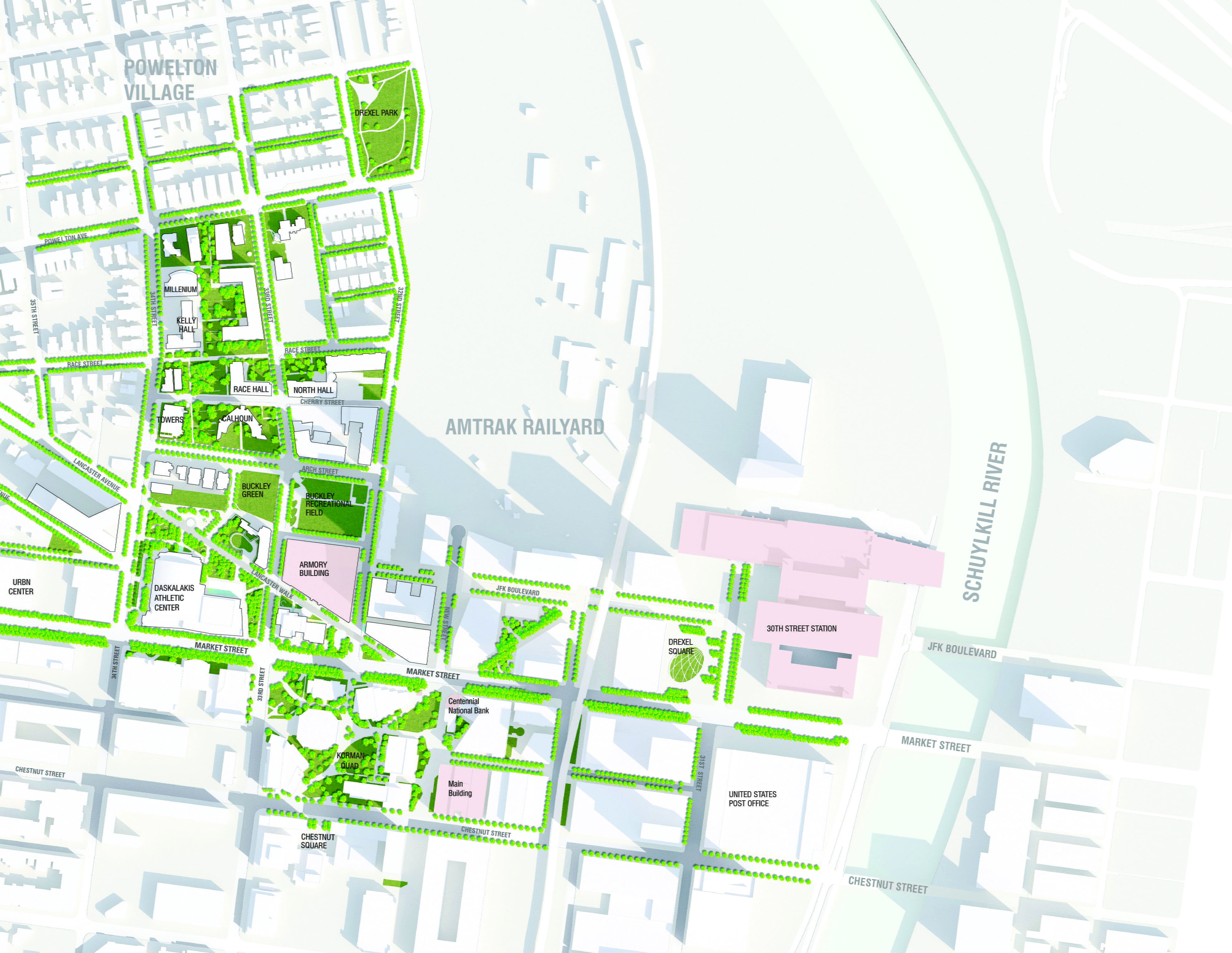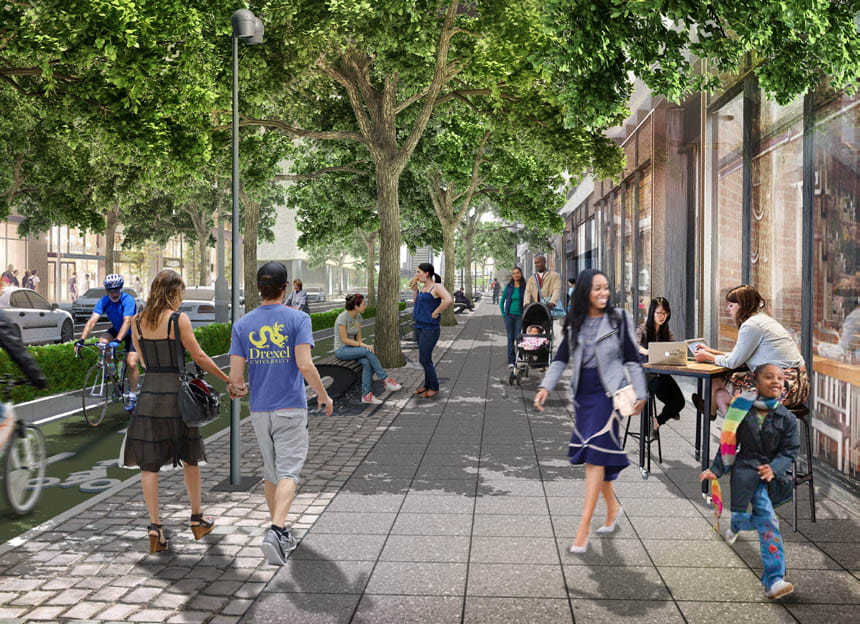Masters of the Realm
 By Katie Clark
By Katie Clark

Anyone who has come to Drexel’s University City Campus in the past five or so years to study, work or play has seen the change. With each new building, and each new enhancement project, the campus is evolving — Drexel’s commuter campus of the past is transforming into one of the liveliest urban pockets in the city of Philadelphia.
Right now, try to get through the area between Gerri C. LeBow Hall and the Korman Center. You can’t, because progress is happening there. A generous gift from the Hyman Korman Family Foundation — and matching funds from the University — has made possible the expansion of the Korman Center and improvements to the area around it, to be named the Korman Quadrangle upon completion this fall. A few hundred feet away is Perelman Plaza, a beautiful new space made recently available to the Drexel community through a gift from the Raymond and Ruth Perelman Education Foundation in 2014.
Projects like these will be popping up all over campus in the coming years — and they’re all connected. They’re part of a larger vision to help the campus reach its full potential and enhance the lives of the people who use it.
That vision, called the Public Realm Plan, is built on the principles of the Campus Master Plan that the University created in 2012, which aims to bring the campus to the street, draw the community around shared spaces and expand the innovation district. The Public Realm Plan was developed by West 8, an international landscape architecture and urban design firm that Drexel hired in 2015.
The plan includes the development of academic spaces as well as inviting outdoor places as respites from the fast pace synonymous with Drexel. The plan calls for changes both small and large: the larger projects include transforming Lancaster Walk, making Market Street more pedestrian friendly and enhancing the student residential neighborhood. Some smaller changes that will still make a big impact are lighting, stormwater systems and the addition of more green space across campus.
“It’s very important that we have these beautiful, quiet, contemplative spaces to help build community here at Drexel,” said Drexel President John A. Fry.

Adding green spaces will do far more than just enhance the campus aesthetically, said Adriaan Geuze, founding director of West 8.
“We strongly believe that a good public realm — with lots of green space — makes peoples lives better,” he said. “That may sound romantic, but we honestly believe that is true. And an investment in new buildings also needs an investment in green and public spaces.”
Fortunately, the designers at West 8 had a strong foundation to build on when developing the plan.
“Drexel already has this interesting urban quality with two boulevards running through the heart of it,” said Geuze. “And the embedding of the University in the city of Philadelphia and the University City District is remarkable.”
The firm also has an enormous canvas to work with. Of the 98 total acres that make up Drexel’s campus, only 40 percent is currently occupied by buildings, leaving 58 acres of places and spaces to learn, interact, play and relax.
The University has limited funding allocated for some of the plan’s projects, Fry said, but its momentum will mostly rely on gifts, like the ones made for the Korman Quad and Perelman Plaza projects.

“This isn’t about luxury, this is a necessary thing to do,” said Fry. “Drexel is inherently a very busy, focused place; people are on a tight schedule moving from thing to thing. On one hand, that productivity is to be respected and celebrated. On the other hand, campuses should also be a little bit about serendipity. They should have beautiful, convivial places that people look forward to using, outside of the classrooms and labs and offices.”
Another area of campus that’s remained largely unaffected by the University’s recent building boom is the student residential neighborhood, an area comprised of seven major residence halls that house nearly 20 percent of the student population.
“Enhancing the student neighborhood will have a huge impact,” said Subir Sahu, PhD, associate vice president and dean of Student Life. “That part of campus is alive, it has a positive energy that I love, but the physical space there doesn’t mirror that. Anything we can do to bring the physical space up to that level is a win for everyone involved.”
The transformation laid out by the public realm plan is just a natural part of Drexel’s evolution, said Fry. And it’s something that everyone — students, faculty staff and even alumni — can enjoy.
Fry noted that “we are developing over time one of the greatest and most powerful urban campuses in America. The people I speak to are astounded by the transformation of the physical campus and are looking forward to seeing more to come. Thanks to the Public Realm Plan, we have a smart playbook to get that done.”
This story originally appeared in the winter issue of Drexel Quarterly.
Drexel News is produced by
University Marketing and Communications.
